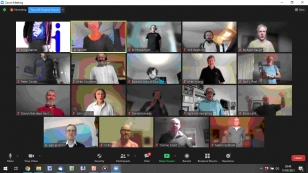In my last post, about my talk on barbershop for Scunthorpe Choral Society, we got to the point where someone asked a really good question, and then it all got too long to answer in one blog post. So we are resuming here, refreshed, and having had a bit more thinking time to consider the question: can you generate the characteristic audible overtones of barbershop expanded sound/lock and ring when making a multi-track recording with yourself?
I’m always a bit slow when thinking about the physics of sound, not least because when given the choice at university, I opted to study Italian for a year instead of acoustics, thinking it would be more useful for a singer. But I’ve learned some stuff since, and my understanding of timbre, vowel perception, and the harmonic series makes me think that in theory, yes, you should be able to do this. The overtones fall well within the range of audible sound picked up by microphones, so the frequencies to be reinforced are clearly present in the sound. Moreover, you’d think that one person singing all the parts has a head start on getting the sound well-matched.




